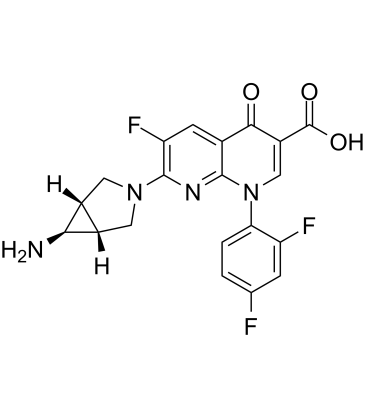Trovafloxacin |
| Catalog No.GC60374 |
Trovafloxacin은 그람 양성, 그람 음성 및 혐기성 유기체에 대해 강력한 활성을 갖는 광범위한 스펙트럼의 퀴놀론 항생제입니다.
Products are for research use only. Not for human use. We do not sell to patients.

Cas No.: 147059-72-1
Sample solution is provided at 25 µL, 10mM.
Trovafloxacin is a broad-spectrum quinolone antibiotic with potent activity against Gram-positive, Gram-negative and anaerobic organisms. Trovafloxacin blocks the DNA gyrase and topoisomerase IV activity. Trovafloxacin is also a potent, selective and orally active pannexin 1 channel (PANX1) inhibitor with an IC50 of 4 μM for PANX1 inward current. Trovafloxacin does not inhibit connexin 43 gap junction or PANX2. Trovafloxacin leads to dysregulated fragmentation of apoptotic cells by inhibiting PANX1[1][2][3].
Trovafloxacin (20 µM; 24 hours; HepG2 cells) and tumor necrosis factor (TNF; 4 ng/mL) incubation induces apoptosis and increases leakage of lactate dehydrogenase (LDH) in HepG2 cells[1].Trovafloxacin (20 µM; 24 hours; HepG2 cells) and TNF (4 ng/mL) incubation increases expression of early NF-κB-related factors A20 and IκBα[1].Trovafloxacin prolongs TNF-induced activation of MAPKs and IKKα/β activation in HepG2[1].Trovafloxacin is a potent inhibitor of TO-PRO-3 uptake by apoptotic cells. Trovafloxacin also inhibits ATP release from apoptotic cells. Trovafloxacin does not inhibit caspase 3/7 activation, or caspase-mediated PANX1 cleavage during apoptosis[2].Trovafloxacin is equally active against both penicillin-susceptible and -resistant pneumococci, with MICs of 0.06-0.25 mg/mL reported for more than 700 isolates. The MICs of Trovafloxacin at which 90% of isolates are inhibited for 55 isolates of pneumococci is 0.125 μg/mL[3]. Apoptosis Analysis[1] Cell Line: HepG2 cells
Trovafloxacin (150 mg/kg; oral administration; male C57BL/6 J mice) treatment disrupts TNF-induced p65 nuclear translocation. Trovafloxacin treatment increases expression of early NF-κB-related factors A20 and IκBα[1].Trovafloxacin, when administered in combination with lipopolysaccharide (LPS) or TNF to mice induces severe liver toxicity associated with vast apoptotic areas in the liver, increased serum levels of alanine amino transferases (ALT) and pro-inflammatory cytokines[1]. Animal Model: Male C57BL/6 J mice (9-11-week-old) injected with recombinant murine TNF ion[1]
[1]. Giustarini G, et al. The hepatotoxic fluoroquinolone trovafloxacin disturbs TNF- and LPS-induced p65 nuclear translocation in vivo and in vitro. Toxicol Appl Pharmacol. 2020 Mar 15;391:114915. [2]. Poon IK, et al. Unexpected link between an antibiotic, pannexin channels and apoptosis. Nature. 2014 Mar 20;507(7492):329-34. [3]. Gootz TD, et al. Activity of the new fluoroquinolone trovafloxacin (CP-99,219) against DNA gyrase and topoisomerase IV mutants of Streptococcus pneumoniae selected in vitro. Antimicrob Agents Chemother. 1996 Dec;40(12):2691-7.
Average Rating: 5 (Based on Reviews and 39 reference(s) in Google Scholar.)
GLPBIO products are for RESEARCH USE ONLY. Please make sure your review or question is research based.
Required fields are marked with *




















